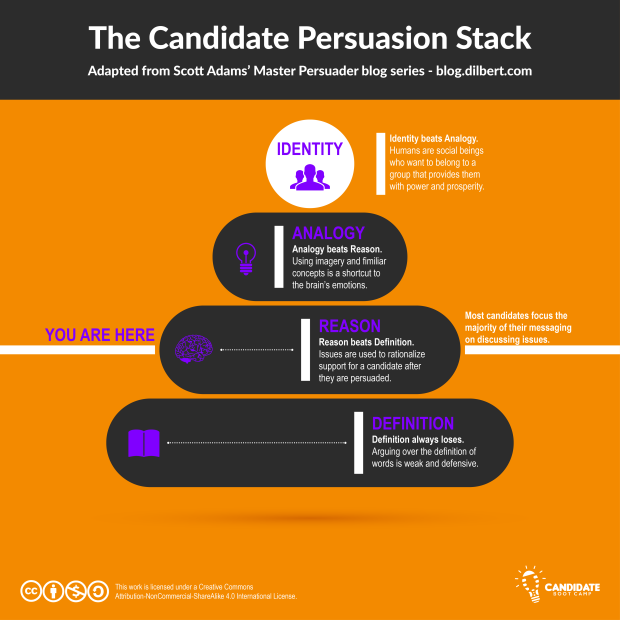As a political candidate, your number one goal is to persuade constituents to vote for you. Like many of life’s most difficult goals, it sounds simple but it’s very difficult. Dilbert cartoonist Scott Adams has been writing a series of fascinating blog posts that analyze the persuasive skills of Donald Trump and there are some very valuable lessons (summarized in the persuasion stack) candidates can learn from it.
I know what you’re probably thinking; Is he serious?
Yes. But before I elaborate, let’s clarify a few things:
- Scott Adams is not just a very successful cartoonist. He’s a trained hypnotist, which means that he’s been studying the art of persuasion for decades.
- This article will examine the relative success (at least so far) of the Donal Trump presidential campaign. It’s not an endorsement and whether you love or hate him, his surge in the polls is real and it bears closer examination.
- Trump is a unique candidate with a specific set of skills and massive financial resources. No local political candidate will have the same advantages. The only person who can run a “Trump campaign” is The Donald himself. However, there are lessons to be learned from Adams’s analysis that anyone can use.
What Is Going On?
 In the summer of 2015, there were very few (if any) pundits who took Trump seriously. They listed a myriad of reasons why he was not a “serious” candidate and predicted his demise over and over and over again. Of course, they were all wrong. His ceiling was higher and his staying power longer than anyone predicted.
In the summer of 2015, there were very few (if any) pundits who took Trump seriously. They listed a myriad of reasons why he was not a “serious” candidate and predicted his demise over and over and over again. Of course, they were all wrong. His ceiling was higher and his staying power longer than anyone predicted.
Except for Adams. Long before anyone else, he saw something different about Trump. That difference was his masterful ability to persuade people. He saw that Trump was playing chess while all of the other candidates were playing checkers.
At the end of this article, I’ll provide a basic strategy that any local candidate can use to formulate their message. But first, let’s deconstruct the Trump phenomenon.
The Master Persuader Filter
Adams insists that the professional pundits and casual observers have been wrong about Trump because they use a traditional, 2D filter. This filter assumes that people vote for candidates because they support the same policies as themselves. But Adams has been using a 3D filter that assumes people use policy to rationalize their support for a candidate after they’ve been persuaded.
So, how has this filter performed over the past six months? Adams has made a series of predictions – some bolder than others – that have since proven to be accurate. Here are a few of his more convincing predictions:
- August – Trump will win the nomination, not fizzle as everyone else was assuming and predicting.
- The “low energy” label by Trump would mortally wound the Jeb Bush campaign.
- He called the top in poll numbers for Fiorina, Carson, and Clinton.
- We would start hearing Freudian slips of “President Trump” from the media.
- And several more…
Now that we’ve seen the uncanny accuracy of his predictions, let’s take a look at some of Trump’s more unconventional tactics.

Consistency
One of Trump’s curious traits is his refusal to ever admit when he is wrong. Regardless of the evidence, he will look up at a crystal blue sky and insist it’s blood red. Adams explains that “It is persuasion 101. The first rule of persuasion is that you nudge the other person, but you NEVER let them nudge you. Let me repeat this word a few times: NEVER NEVER NEVER NEVER NEVER NEVER… What you see in the 2D world is Trump the egomaniac who ‘can’t admit when he is wrong!’ What I see in the 3D world is the most disciplined persuader I have ever seen. Trump intentionally accepts the scorn of many as a cost of winning. And it works.”
Jiu-Jitsu
 Brazilian Jiu-Jitsu is a martial art that relies heavily on leverage, such that a smaller fighter can use a bigger adversary’s weight and momentum against themselves. Trump is a master at reframing conversations and creating win-win situations.
Brazilian Jiu-Jitsu is a martial art that relies heavily on leverage, such that a smaller fighter can use a bigger adversary’s weight and momentum against themselves. Trump is a master at reframing conversations and creating win-win situations.
In one example, when Trump was trailing in the Iowa polls he inoculated himself against losing. First, he went to Iowa and called the voters stupid. Specifically, he said, ‘‘How stupid are the people of Iowa?’’ to believe Ben Carson’s story. Any other politician would have been closing down their campaign within 48 hours after a statement like that. But what he did was to issue the Iowa voters a challenge: Vote for me and be smart, or vote for Carson and be dumb. He later doubled down and told them “You have not picked a lot of winners. And that will make me feel good only if I don’t make it with Iowa.” He created a win-win situation. If he wins, they smartened up. If he loses, they simply haven’t learned their lesson.
Another example of this technique surfaced when Clinton said that, “Terrorists are using Trump in recruitment videos.” His response was, “Of course they go after the person with a HUUUUGE lead in the polls. I predict they will make more.” The irony of this situation was that it was false! But he didn’t object on those grounds. He actually used the weight and momentum of his opponent against herself by predicting that ISIS not only should be making videos about him but predicted they would make more (which they did). Another win-win situation.
Language
Trump’s use of language is far more deliberate than many people realize. One of his techniques is to use language that is very easy to digest. Some use it as evidence that he is an “idiot,” because his speeches tend to measure out at a fourth-grade level. Esquire magazine ran an article with a subtitle saying, “His competitors from both parties aren’t much better.” The obvious assertion there is that using more complex language is a sign of higher intelligence and, therefore, is “better.” But as a professional marketer, blogger, and published author, I’m here to tell you that simple is better. Much better. Simple works. Regardless of how intelligent a person is, they will always prefer simple over complex. It requires less energy.
Another tool in Trump’s belt is hyperbole. Once again, many observers and pundits will cite this as evidence of his stupidity. How stupid do you have to be to suggest that we’ll build a wall and have Mexico pay for it? What kind of moron would suggest we’re going to deport 15 million people? Only an idiot would believe that he hires people to build him websites that cost $3. So what is Trump doing with this obvious hyperbole? Answer: He’s negotiating. If you’ve read any of his books, including The Art of the Deal, you know that this is vintage Trump. He always begins a negotiation by taking an extreme position, which has the effect of putting the other party on defense.
It also takes advantage of a marketing technique called “anchoring.” This is why you so often see a higher price crossed out with a lower price next to it. Even though it’s a phony price, it makes the regular price more palatable. You may think you’re immune to such trickery, but A/B testing would prove you wrong.
Metaphor
Another technique Trump uses frequently and effectively is the metaphor. This is also a copywriting tactic that helps people see your point more quickly and with less effort. Here are 5 Reasons Why Metaphors Can Improve the User Experience:
- Metaphors Can Put Abstract Concepts in Concrete Terms
- Metaphors Create Familiarity
- Metaphors Can Trigger Emotions
- Metaphors Can Draw the Attention of Users
- Metaphors Can Motivate Users into Action
Now that we’ve covered some of Trump’s “Master Persuader” techniques, see how many of them you can spot in this video:
The Persuasion Stack
Your job as a candidate is to market yourself to your constituents. I’ve outlined a number of tactics above, but what’s the overall strategy? Adams refers to a Persuasion Stack, which ranks the effectiveness of different strategies.
- Identity
- Analogy
- Reason
- Definition
It just so happens that this persuasion stack is very similar to the approach used by marketers for designing advertisements and landing pages. The most persuasive messages tap into human identity and use analogy and reason as backup. While it may sound simple – and it is – that does not mean it’s easy.
Blair Warren is a television producer, writer, marketing consultant and voracious student of human nature. He is the creator of The Forbidden Keys to Persuasion E-Class and author of The No-Nonsense Guide to Enlightenment and The Book on Spin: The Art of Turning (Almost) Anything to Your Advantage. He wrote a free ebook (no longer available) called The One Sentence Persuasion Course. And taking his own advice, he delivers the goods in one sentence:
People will do anything for those who encourage their dreams, justify their failures, allay their fears, confirm their suspicions and help them throw rocks at their enemies.
Let’s wrap up by cross-referencing these tactics with some of Trump’s messaging:
- Encourage their dreams – “We’re going to make America great again.”
- Justify their failures – “The U.S. has become a dumping ground for everybody else’s problems.”
- Allay their fears – “I will build a great wall — and nobody builds walls better than me, believe me —and I’ll build them very inexpensively. I will build a great, great wall on our southern border, and I will make Mexico pay for that wall. Mark my words.”
- Confirm their suspicions – “Free trade is terrible. Free trade can be wonderful if you have smart people. But we have stupid people.”
- Throw rocks at their enemies – “I watch the speeches of these people, and they say the sun will rise, the moon will set, all sorts of wonderful things will happen, and people are saying, ‘What is going on? I just want a job.’”
Conclusion
Again, this article is not about praising or endorsing Donald Trump. Rather, it’s taking the opportunity to learn from his early success. There probably isn’t another human being alive that has the combination of his skill set and wealth. That means one must be careful not to think that his success can be copied. However, if you deconstruct some of his tactics, there is definitely a blueprint that any candidate can use to be more persuasive.
Image credits:
Featured image courtesy of ibmphoto24 on Flickr
Donald Trump courtesy of Gage Skidmore on Flickr
Master Yoda courtesy of Alex Abian on Flickr
Brazilian Jiu Jitsu courtesy of Wikimedia Commons


